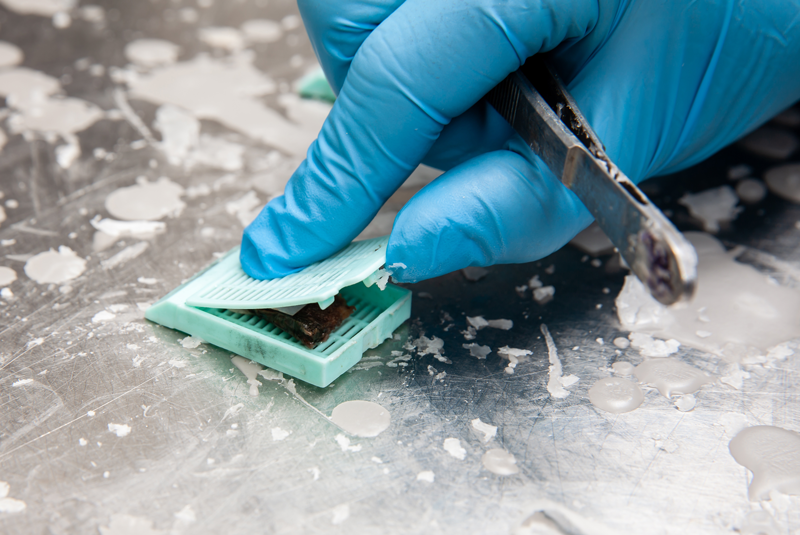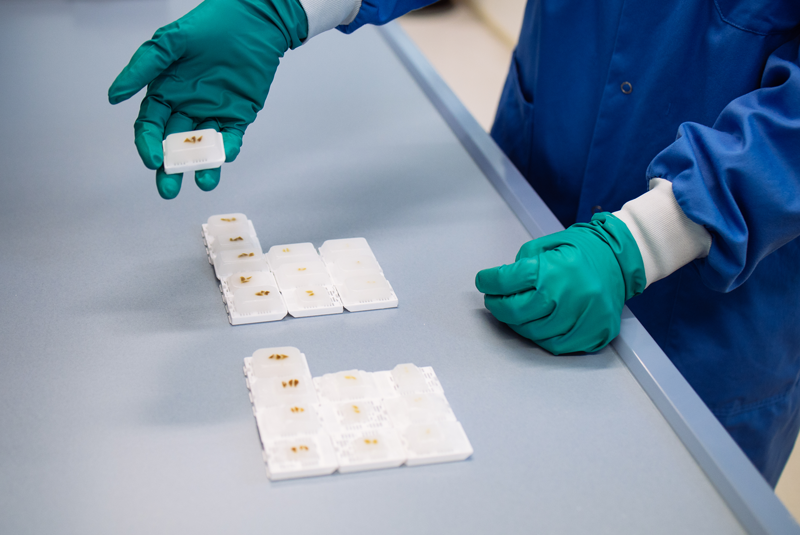When a patient undergoes a biopsy or surgery, tiny pieces of tissue are removed and preserved with formalin and paraffin (wax) in a form called formalin-fixed paraffin-embedded (FFPE) samples for immediate and future use. In the form of FFPE samples or FFPE blocks, tissues are stable for years or even decades. Clinically relevant FFPE samples prepared from biopsies are collected so that pathologists or physicians can refer to them for new insights or second opinions during a patient’s treatment. Researchers have also preserved donated human tissues or materials collected from animals (most commonly laboratory mice) to create archives of materials for future study, basic research, or preclinical studies. FFPE samples are archived in “biobanks” developed by universities and hospitals or created for commercial purposes by companies serving the research community and are therefore often referred to as “biobank samples”.
FFPE samples present a unique window into the past for scientific exploration. They are valuable tools, precious archives widely used in research, especially in cancer research, immunology, and drug development. In addition to their traditional use for morphological studies, which are essential for diagnostic and predictive purposes, FFPE samples are a source of DNA and RNA for genomic and transcriptomic analysis, even after decades of storage.
The importance of FFPE samples for modern research prompted us to work on an FFPE RNA EXPERTise blog series. The series will cover different aspects of FFPE samples, including their preparation, potential challenges, precautions, and applications, particularly in next-generation sequencing studies. We will analyze the benefits of using different RNA-Seq approaches and provide the best practices for FFPE RNA-Seq.
Let’s start by exploring the details of FFPE sample preparation and potential challenges and precautions to take. And…stay tuned for more updates!
How to prepare FFPE samples?
Preparation of FFPE samples is a meticulous process designed to preserve tissue integrity for all subsequent analyses (Figure 1). When properly prepared, FFPE samples are remarkably stable and can be stored at room temperature for extended periods of time, ranging from years to decades. FFPE tissue samples are stored in tissue banks, research centers, or laboratories. Information about the stored tissue, including collection date, preservation details, and donor demographics, must be collected and properly documented to ensure that the samples can be used for future studies.

Here is a step-by-step overview of how to prepare FFPE samples. More detailed protocols can be found in various scientific journals or are published online by research institutions and hospitals (Blow, 2007; Kirstie Canene-Adams, 2013). On www.protocols.io , online database for laboratory protocols, there is also a lot of FFPE-related material available.
1. Tissue Biopsy
Fresh material is obtained by taking biopsies of the organs or tissues of interest. The condition of the fixed tissue must mimic the organic tissue as closely as possible. To achieve this, the tissue must be fixed as soon as possible after removal from the patient/donor/laboratory animal.
2. Fixation
The fixation process starts after tissue dissection. Tissue sections are incubated in the fixative formalin (formaldehyde), which penetrates the tissue and cells and halts all cellular processes by cross-linking proteins, DNA and RNA, thereby preserving the structural and molecular components of the tissue. The duration of formalin fixation is critical and varies with tissue type and size. Optimal fixation times typically range from 6 to 24 hours, ensuring thorough preservation without compromising molecular information.
3. Dehydration
After fixation, the tissue must be dehydrated to allow for complete penetration of the tissue by the paraffin wax that will preserve the tissue. At this step, almost all water is removed from the sample, since wax is not soluble in water. Therefore, the sample is gently dehydrated by immersing the samples in a graded series of ethanol solutions, ending with pure 100 % ethanol.
NOTE: If one were to simply immerse the sample in 100 % ethanol, degradation of the sample and proteins could occur. Improper dehydration can result in incomplete saturation of the sample with paraffin wax and, consequently, softness of the tissue.
4. Clearing
The clearing agent added in this step displaces ethanol and removes fat from the tissue (clears the tissue) to allow the paraffin wax to fully penetrate the tissue for the final preservation step. Xylene is a commonly used clearing agent, but due to its toxicity, isopropanol is often used as an alternative, less toxic solution.
IMPORTANT: If isopropanol is used, embedding is done with wax of higher temperatures.
5. Paraffin Embedding
After clearing, the tissue is embedded in hot paraffin at approximately 60°C. Paraffin solidifies as it cools and provides structural support for the tissue, allowing it to be easily sectioned for various types of examination (Figure 2).

Challenges while preparing FFPE samples
As mentioned above, the preparation of FFPE samples is a rather painstaking process which comes with its set of challenges, that may impact the quality of the sample. Quality control measures are implemented throughout the process to ensure the integrity of the FFPE samples. A certified medical pathologist may be involved to determine the quality of the prepared samples.
We have listed here some of the key challenges (or in other words, critical steps to be mindful of) while preparing FFPE samples.
Duration of fixation
The duration of formalin fixation is critical. Too short fixation times may result in inadequate preservation, making samples unsuitable for molecular studies. On the other hand, too much fixation can lead to excessive protein cross-linking, which may affect the quality of the nucleic acids.
Tissue size and thickness
Larger or thicker tissue specimens may present challenges during the fixation and embedding process. Formalin penetration may be limited in thicker tissues, affecting the uniform preservation of the entire tissue specimen.
Decalcification
Tissues containing calcified structures, such as bone, may require decalcification prior to formalin fixation. However, this process can result in loss of nucleic acids and proteins, which can affect the overall quality of FFPE samples.
Influence of ischemic time
The time between tissue removal and fixation, known as ischemic time, can affect the quality of FFPE samples. Prolonged ischemic times can lead to cellular degradation, compromising the molecular and structural integrity of the tissue. During surgery, tissue biopsies are usually immediately placed in fixative. This immediately stabilizes the specimen and allows it to await preservation.
Artifacts
The process of paraffin embedding can introduce artifacts into tissue sections. Improper embedding may result in incomplete or uneven sections, which will affect the accuracy of all subsequent analyses.
Protein denaturation
Formalin fixation can denature proteins, making them less accessible to antibodies during immunohistochemistry (IHC). This may affect the reliability of protein detection and staining.
RNA degradation
RNA is particularly susceptible to degradation during preparation of FFPE samples. The fixation process and storage conditions can lead to fragmentation and chemical modifications, impacting the feasibility of RNA-based analyses. Transcriptional profiling of RNA from FFPE samples can bring great value to modern research of diseases. In one of our future blog articles, we will focus on the challenges and best practices for FFPE RNA sequencing (RNA-Seq) and transcriptome profiling from FFPE samples.
Impact on DNA Sequencing
Formalin fixation process may introduce artifacts or mutations in the DNA, which can complicate the accurate identification of genetic alterations.
FFPE RNA EXPERTISE blog series: What is coming next?
In our second blog article, we discuss the most common applications of FFPE samples in modern research and the importance of next-generation sequencing studies on them.
References
Blow, N.2007448 (2007). Tissue preparation: Tissue issues. Nature 448, 959-963. DOI: 10.1038/448959a
Kirstie Canene-Adams2013533 (2013). Chapter Fifteen – Preparation of Formalin-fixed Paraffin-embedded Tissue for Immunohistochemistry. In Laboratory Methods in Enzymology: Cell, Lipid and Carbohydrate, Jon Lorsch, ed. (Academic Press), pp. 225–233.
Written by Masa Ivin, PhD








